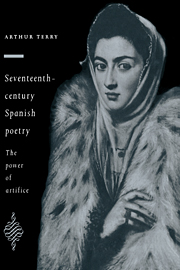Book contents
- Frontmatter
- Contents
- Preface
- List of abbreviations
- 1 The inheritance
- 2 Theory and practice
- 3 Luis de Góngora: the poetry of transformation
- 4 Lope de Vega: re-writing a life
- 5 Between two centuries: from Medrano to Valdivielso
- 6 Francisco de Quevedo: the force of eloquence
- 7 The literary epic
- 8 Plenitude and decline: from Villamediana to the second half of the century
- 9 Sor Juana Inés de la Cruz: the end of a tradition
- Epilogue
- Notes
- Select bibliography
- Index
5 - Between two centuries: from Medrano to Valdivielso
Published online by Cambridge University Press: 01 October 2009
- Frontmatter
- Contents
- Preface
- List of abbreviations
- 1 The inheritance
- 2 Theory and practice
- 3 Luis de Góngora: the poetry of transformation
- 4 Lope de Vega: re-writing a life
- 5 Between two centuries: from Medrano to Valdivielso
- 6 Francisco de Quevedo: the force of eloquence
- 7 The literary epic
- 8 Plenitude and decline: from Villamediana to the second half of the century
- 9 Sor Juana Inés de la Cruz: the end of a tradition
- Epilogue
- Notes
- Select bibliography
- Index
Summary
The poetry of Góngora and Lope de Vega takes shape in an atmosphere of intense literary activity which, though difficult to reconstruct, impinges at many points on their own writing careers. The most obvious sign of this is the number of talented minor poets writing about the year 1600, a fact registered in the numerous verse anthologies of the time, such as the Romancero general (1600–5) and the Flores of Espinosa (1605). Thus, although none of the poets I shall be concerned with in this chapter could be described as ‘major’ – several, like Medrano, Carrillo, Arguijo and Rioja, died young or ceased to write poetry at a relatively early age–each adds a distinctive note to the poetry of the time and, in doing so, indicates some of the possibilities which lay open to Spanish poetry in the years preceding the appearance of Góngora's major poems.
Since over half the poets I shall be considering are Andalusian – the majority connected with Seville itself – this raises the possibility of an Andalusian ‘school’, a notion still current in certain histories of literature. However, the idea of a ‘school’, with its suggestion of a master and disciples, seriously distorts the kind of relations which actually existed among the poets of the time and does little justice to the variety of poems they produced. Again, despite their mutual admiration for Herrera – above all as an example of artistic integrity – their work often diverges very noticeably from Herrera's own practice or at the very least transposes his peculiar kind of verbal refinement to a different context.
- Type
- Chapter
- Information
- Seventeenth-Century Spanish Poetry , pp. 122 - 151Publisher: Cambridge University PressPrint publication year: 1993



